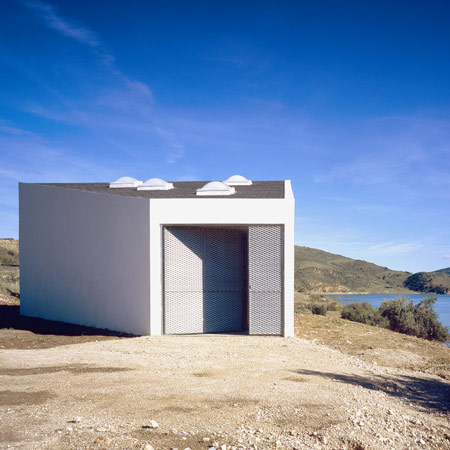Spanish architect Julio Barreno has completed a storage building for canoes next to a reservoir in Zahara de la Sierra, Spain.
Called Canoes Landscape, the project was shaped by the location of the road behind, electrical lines, possible flood-levels of the reservoir and the instability of the ground.
The tapered interior features a large space with racks for storing the boats, lit by skylights.
Changing rooms, toilets and a shower are concealed behind a red-tiled wall.
Here's some more information from Julio Barreno:
--
CANOES LANDSCAPE
Zahara de la sierra is a small village in the south of Spain.
It is situated on the top of a hill as a dense liquid falling down along the slope.
At the bottom, there is a reservoir constructed with a concrete dam.
The town council plans construct a recreation area in the lower site of the hill which is next to the water reservoir.
As we can see, the landscape in this area is formed by small white pieces of housing derived from the small size of the plots and the properties in this area define the green and white pixels of an aerial view of this landscape.
This building for storing canoes is built as another white point in the landscape
Three lines decide the exact situation in the site:
The narrow road going from the secondary one to the water level, the electrical aerial line (electrical installation) crossing above the site and the water level of a sudden increase (when it rains a lot, the rivers can grow up quickly and when this rain arrives into the reservoir, it can create waves making the water level grow up to this maximum level of the water).
These conditions along with others like the bad soil for foundations decide what the building becomes.
With these conditions it was difficult to design something based on a perpendicular geometry, a regular volume.
So, it started to deform, it became a deformed geometry volume, that sums up the answers to the conditions that the site imposed.
On the other hand, the building is a BY-PASS connecting the parking site, at the beginning of the secondary road, with the jetty, on the water level, the proposal designs a path between these two points; people get in through a pedestrian access with their everyday clothes, and go out through the other extreme exit with the canoe and sports clothes on their way to the water in the reservoir.
In this sense, the building becomes an INTERCHANGER, as a stop, a halt in the path.
For the construction of this element we used the current materials of this area; the white colour as the main ingredient and inclined black tiled roof with some white disseminated skylights.
These characteristics give the building a certain landscape character. It could be called a BUILDING-LANDSCAPE, a CANOES´S LANDSCAPE.
In this way the building emerges as another white element in the traditional landscape in this region.
We developed the program with only one floor; the main one is a big space for storing the canoes, and another server spaces concentrated in a small red piece including showers, toilets and changing rooms.

